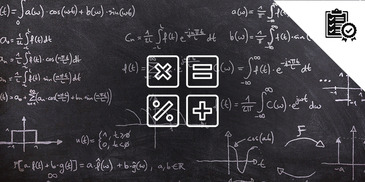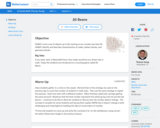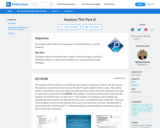
Students watch their 100 Students video and reflect on their learning during the project.
- Subject:
- Mathematics
- Material Type:
- Lesson Plan
- Provider:
- BetterLesson
- Date Added:
- 12/01/2022


Students watch their 100 Students video and reflect on their learning during the project.

What makes a question a statistical question? Students learn about statistical and non-statistical questions and then use that knowledge to brainstorm survey questions for their classmates.

Students learn about statistics and the process of doing statistics as an introduction to the 100 Students Project they will conduct about themselves and their classmates.

This lesson is More or Less a great lesson! Engage students in finding 10 more and 10 less than a number using these fun activities. Includes an eSpark video on place value, detailed lesson plan, copy of a hundreds chart, and practice worksheet.

Through a counting game called 20 Beans, students count a set of objects up to 20, starting at any number less than 20.

Students explore cube nets in an effort to understand what properties are common to all nets that form a cube. Students work hands-on with nets and are then pushed to use their experience to visually determine whether other nets will form a given figures.

Students work with 3-digit numbers as they solidify their understanding of the difference between perimeter and area.

Students practice graphing ordered pairs on IXL math and on a worksheet to create a picture.

Students learn how to properly add and subtract decimal quantities.

Understanding that when the total number of parts of a whole are the same, fractions can be added.

Students work with a number line and football to model adding and subtracting integers.

Students will apply the idea of adding or subtracting ten to a number by adding or subtracting multiple groups of ten from a number. Included is a detailed lesson plan, videos of the lesson in action, materials and worksheets, and center ideas.

Students fluently add and subtract money with decimals using the standard algorithm.

Students add and subtract fractions using a common denominator.

Students will use their addition and subtraction strategies to measure and compare distances, solving using centimeter units.

Think of addition in the real world as the joining of two parts to make a whole. The use of addition number sentences can show how we join the parts to make the whole.

A lesson plan where students will interpret the trigonometric functions in terms of the unit circle, graph a sinusoidal function, and use a sinusoidal function to make interpretations in a modeling context.

Fractions can help one understand the basic properties of elements.

Finding measures of central tendency will be applied to the different graphs throughout this unit.

Srudents connect mean, median, mode and range to real life. It will allow students to make sense of problems by using previously taught strategies.